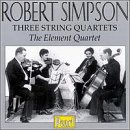| All Artists: Robert Simpson, The Element Quartet Title: Robert Simpson: Three String Quartets Members Wishing: 0 Total Copies: 0 Label: Pearl Release Date: 8/18/1998 Genre: Classical Styles: Chamber Music, Symphonies Number of Discs: 1 SwapaCD Credits: 1 UPC: 727031002321 |
Search - Robert Simpson, The Element Quartet :: Robert Simpson: Three String Quartets
 | Robert Simpson, The Element Quartet Robert Simpson: Three String Quartets Genre: Classical
|
Larger Image |
CD Details |
CD ReviewsIntense Quartet-Trilogy by Simpson in Private Recordings Thomas F. Bertonneau | Oswego, NY United States | 10/14/2000 (5 out of 5 stars) "Robert Simpson (1921-1997) wrote in a deeply personal style which nevertheless admitted its influences, those in particular of Beethoven, Nielsen, and Bruckner, but also of Schoenberg. Like several other mid-to-late-twentieth century composers, Simpson managed to find a compromise between tonality and a species of serialism; he will often manipulate a strongly tonal theme the way that Schoenberg manipulated his (non-tonal) rows. This results in a music which evolves seamlessly but remains oriented to well- defined tonal centers. Simpson produced eleven symphonies and fifteen string quartets, as well as a good deal of other music in a variety of genres. (But no opera.) The fifteen string quartets constitute an oeuvre every bit the equal of contributions made to the identical literature by Schoenberg himself, by Bartók, and by Shostakovich (who also turned in fifteen). The argument could indeed be made that in scale and complexity, Simpson's fifteen surpass those of the prolific Russian - a possibility that if true might explain why Shostakovich now strikes us as fairly familiar while Simpson still poses something of an enigma. One of Simpson quartets, the Ninth, consists of no less than thirty-three palindromic variations and a palindromic fugue on a palindromic theme by Haydn; this work lasts nearly an hour in performance and aspires to a genuinely symphonic grandeur. Whereas Shostakovich's first quartet only modestly and tentatively tests the format, Simpson's tackles the genre audaciously with big gestures. In fact, Simpson's first three quartets form a cohesive group and comprise, in their overall architecture, a unified grand quartet in triptych. Pearl's recent release of Simpson's Quartets Nos. 1 through 3, recorded by the Element Quartet when the ink on the score-paper had hardly dried, makes for a good introduction to the composer and offers an intimate view of the material. The recordings come from acetates (No. 1) and tapes (Nos. 2 and 3) made privately by Simpson as a memento of the performances (1953 for No. 1 and 1954 for Nos. 2 and 3). Right away in Quartet No. 1, we hear the Nielsen influence, in the rocking ostinato over which much of the musical eventuation seems to unfurl. Much of the First Movement of the two-movement Quartet No. 1 sounds fugal, if it be not in fact a strict fugue "disguised" underneath the trappings of sonata-form. The Second Movement slows down considerably, beginning as an Andante and concluding "Gravely." Here Simpson reworks material from the First Movement by augmenting the note-values and by shifting from major to minor. Quartet No. 2 requires only a single movement. The kinship, the direct derivation from Quartet No. 1, will strike the listener immediately. Quartet No. 3 returns to the two-movement format of No. 1, so that the symmetrical pattern of the three works taken together is 2/1/2, a perfect arch. The concluding (second) movement of No. 3, however, is an Allegro Deciso, in contrast to the Grave of the corresponding movement in No. 1. This might be a good place to plug the extraordinary recorded lecture, with musical illustrations, given by Malcolm MacDonald about the Simpson quartets on Dunelm records. The Pearl issue is an incalculably important addition to the recorded archive of twentieth century chamber music."
|

 Track Listings (5) - Disc #1
Track Listings (5) - Disc #1